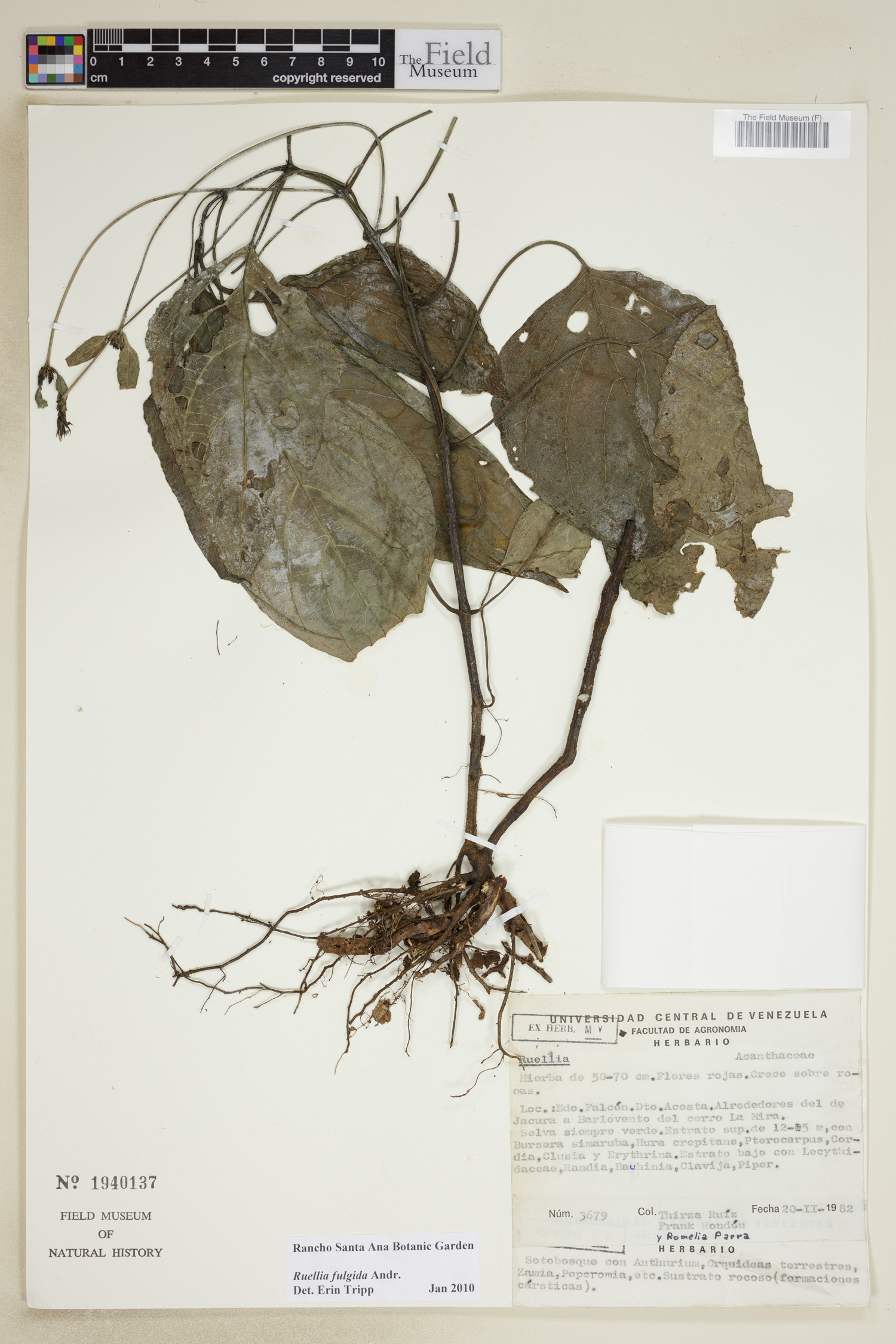
|
Family: Acanthaceae
|
1. Ruellia fulgida Andr. var. angustissima (Hochr.) Leonard, comb. nov. Arrhostoxylum fulgidum Nees var. angustissimum Hochr. Bull. N. Y. Bot. Gard. 6: 287. 1910. Type collected at La Paila, El Valle, Colombia, April 1853, by Holton, No. 599, deposited in the herbarium of the New York Botanical Garden. Isotype in the herbarium of the Royal Botanic Gardens, Kew. Herbaceous or suffrutescent plants; stems quadrangular, sulcate, pubescent or glabrate, the hairs minute and curved; leaf blades lance- olate, sometimes falcate, usually 5 to 9 cm. long, 2 to 3 cm. wide, slen- derly acuminate (the tip itself blunt), narrowed at base and decur- rent on the petiole, both surfaces glabrous or sparingly pilose or the upper surface of the young leaves rather densely pubescent, the hairs straight or curved, the cystoliths prominent where not obscured by hairs; petioles usually 0.5 to 1 cm. long, glabrous or more or less plubescent; flowers sessile or subsessile, borne in heads at the tips of slender curved quadrangular axillary peduncles up to 11 cm. long, these glabrous or sparingly pilose, the cystoliths prominent; flowers several to a dozen or more in each head; bracts subtending the heads leaflike, up to 3 cm. long and 8 mm. wide; bractlets triangular to ob- lanceolate, 2 to 4 mm. long, about 1 mm. wide, glabrous or pubescent; calyx 4 to 8 mm. long, puberulous, some of the hairs glandular, the seg- ments linear, 0.5 to 0.75 mm. wide; corolla red, glabrous or puberulous toward base, the tube funnelform, curved, 1.5 mm. broad at base, 5 to 7 mm. broad at mouth, the lobes ovate, 7 to 10 mm. long, 3 to 5 mm. wide, rounded at tip; stamens exserted to about 5 mm. beyond the mouth of the tube, the anthers oblong, 2 mm. long, 0.5 mm. wide; cap- sules 12 or 13 mm. long, 3 mm. broad, 8-seeded, puberulous, pointed at tip, the solid stipitate base about 4 mm. long and 1 mm. broad; retina- cula slender, curved, about 2 mm. long; seed (immature) flat, orbicu- lar, 1.5 mm. in diameter. A sheet of Lehmann's No. 4739 in the Berlin Herbarium (photo in U. S. National Herbarium) bears in Lindau's handwriting an appar- ently unpublished name. The variety angustissima differs from the typical form R. fulgida chiefly in the narrowness of the leaf blades and the shortness of the petioles. As Hochreutiner points out in his original description, the leaves of the typical form are 7.5 to 12 cm. long and 1.7 to 2.5 cm. wide and the petioles 2 to 8 cm. long. The height of the plant can scarcely be ascertained from the herbarium material examined, but a portion of the original label shown by the photo of the Berlin Herbarium sheet of Lehmann's No. 4739 bears the following legend: "Straucher dunnen, bei 1 m. hohen Stangel, Blat...." The plants are prob- ably erect when young, the stems ascending or even becoming pro- cumbent with age. Damp thickets or woods. Colombia, Venezuela, and Tobago. CUNDINAMARCA: Vicinity of Bogotá, Bro. Ariste-Joseph, s. n. (US). Hacienda Paramillo, between Guaduas and Alto de Aguaclara, Garcia-Barriga 12322 (US). Santandersito, Silvano-J. 178 (GH). Tenasuca, Triana s. n. (Col, NY, US). ANTIOQUIA: Dabelba, Lehmann 4739 (US). EL VALLE: La Paila, Holton 599 (NY). SANTANDER: San Gil, Bro. Antonio-Miguel 121 (GH). WITHOUT LOCALITY: Lehmann 4739 (US). |







